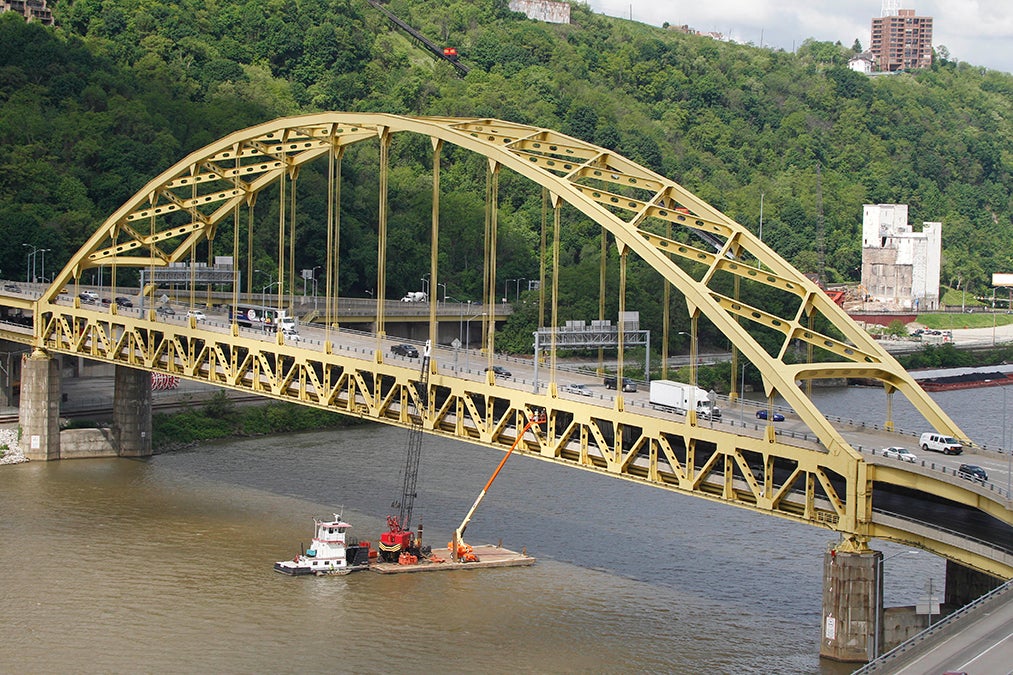Report: Action plan for improving opportunities for black men in Pittsburgh

The Ft. Pitt Bridge over the Monongahela River in Pittsburgh. (AP Photo/Keith Srakocic)
A new study shows systemic lack of opportunity for black men, even as the city begins to improve.
There is a lot of evidence that, after decades of stagnation and decline, Pittsburgh is finally on an upswing. Steel is gone, replaced with the booming ‘eds and meds’ sector. The population is growing again and there is a welcoming environment for small businesses and entrepreneurs.
But that redevelopment isn’t reaching everyone, according to a new study from The Urban Institute. Black men are facing disproportionate unemployment, discrimination and lack of opportunity in the workplace. As Pittsburgh improves, the city is in danger of leaving a whole group behind.
Structural barriers
The Heinz Endowments paid The Urban Institute $180,000 to create “Bridges and Barriers,” a 67-page report on race and economic development in Pittsburgh. The report found that geographic and social isolation of minorities make Pittsburgh one of the most segregated cities in the country.
“Pittsburgh is different from some cities in the way its historical baggage follows it into a more modern economy,” says Urban Institute fellow Margaret Simms, a co-author of the report. “The legacy of the steel industry, in terms of union discrimination and exclusion from certain markets, carries over and becomes part of the restructuring.”
Simms says a system of discrimination existed when times were good for Pittsburgh. William Generett, president of Urban Innovation21, a public-private partnership to encourage entrepreneurship in Pittsburgh, says the collapse of the steel industry was even worse for black men.
“When we had to fight to get the economy back on sure footing, we saw an economy transformed into something that was very different than before,” says Generett. “The good jobs require education and are much more competitive. Pittsburgh is a relational city and the jobs go to people who cross paths with people in power.”
The effect of the new economy can be seen in the unemployment rate in Pittsburgh. Between 2007 and 2011, unemployment was 5.1 percent for white men with at least a high school diploma. Black men in that same demographic faced 12.2 percent unemployment, more than double their white peers.
And blacks make up only 5.4 percent of the region’s male workforce, even though they represent 11.4 percent of the male population.
This divide has the potential to grow as Pittsburgh’s economy improves. The study found that “workers prepared and able to benefit from new jobs and business openings will have many opportunities. But those workers who are not positioned to take advantage of the change may find it difficult to survive and advance economically.”
Generett says it’s a matter of getting people the training that they need to be competitive hires. And then, “often we see African-American men that are qualified not getting those jobs. Those that are qualified we need to see them get connected to those jobs.”
Expensive and inaccessible job training, exclusions based on criminal record and discriminatory hiring practices combine to make the modern economy out of reach for many black men.
Hope for the future
Larry Davis, the director of the Center on Race and Social Problems at the University of Pittsburgh, says these alarming statistics should wake people up to where the city is heading—before it gets there.
“People say the revitalization is leaving black men behind, but it’s so new,” says Davis. “We’re just getting started here in Pittsburgh and there’s no reason that black men can’t be part of that future.”
As Pittsburgh grows, there is greater demand for a workforce, and the city could be poised to be more inclusive and open to diversity at this time.
An unnamed stakeholder was interviewed for the study and said, “We need to make sure that everyone in the region who can and wants to work has the education and training to do that. I think the message from an economic perspective is we have no people and no children to spare if we want our economy to remain strong and be diverse. [We] need to close that [racial] gap.”
The report offers a number of concrete solutions for Pittsburgh:
Increase access to small business funding. Without access to collateral (like a house) or good credit, traditional lending avenues are closed to parts of the black community.
Create job networking opportunities and incentivize companies to look beyond traditional social networks.
“Ban the box” that anyone arrested of a crime must check, which discriminates against a population disproportionately affected by the criminal justice system.
There are many cities in the Rust Belt and beyond that are experiencing similar growth, and facing similar challenges when it comes to getting the effects of that growth to everyone.
But are there any cities that Pittsburgh can look to as an example? Cities that have successfully bucked the trend and brought the advantages of urban renaissance to black populations?
“None come to mind,” says Simms. “I’m sure there are some that do better than others, but no, none come to mind immediately.”
Generett, a lifelong Pittsburgher, is cautiously optimistic about the city’s future. He says history has proven that, “if Pittsburgh wants to get something done, they’ll get it done.” He just hopes changing structural impediments to equal opportunity is the next item seriously on the city’s to-do list.
WHYY is your source for fact-based, in-depth journalism and information. As a nonprofit organization, we rely on financial support from readers like you. Please give today.


